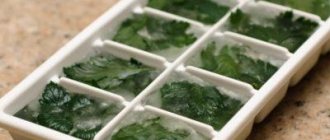Can it be frozen?
Petiole celery can be frozen . This limits the possibilities of its further use - thawed stems will no longer be elastic and crispy, so they will have to be used for preparing hot dishes, not in salads.
But, if we are talking about long-term storage, freezing is the best option, since the vegetable can be stored in the refrigerator without freezing for longer than a few days. Drying is impossible without the use of special equipment. Freezing is quite simple, the main thing is to follow the instructions.
Pros and cons of the storage method
Benefits of freezing:
- About 90% of vitamins and almost 100% of microelements are preserved, in contrast to storage, for example, in a cellar.
- Vegetables retain their taste, aroma and color. When quickly frozen, they also retain the shape of fresh petioles.
- Freezing is a simple and quick process that can be done at home.
- No need to use preservatives such as salt, vinegar, etc.
Freezing has only one drawback: strict storage conditions - a constant low temperature is required.
Important!
Vegetables can only be defrosted once - before cooking. Repeated freezing will negatively affect the quality of the product.
Properties of celery
There are several varieties and varieties of celery: root, petiole and leaf. Private farms and greenhouse enterprises widely use the cultivation of petiole varieties to supply the population with greens throughout the year. Thanks to this, there are always types of root and petiole vegetables on store shelves.
The only difference between different parts of the plant is the set of useful elements. For example, the root contains more natural sugars and some microelements, and the green parts are saturated with vitamins, macro- and microelements, while having a lower calorie content. In terms of vitamin C content, celery root is comparable to lemon and tangerine and surpasses other root vegetables (parsley, parsnips).
Benefit
The beneficial properties of celery are explained by a set of valuable substances and compounds in the vegetable. It can be used for medicinal purposes and in dietary nutrition.
- Here is a short list of the best beneficial properties of this plant:
- taste characteristics are widely used in cooking in the preparation of such dishes - vitamin salads, main courses, juice, smoothies, cocktails;
- low calorie content allows you to fight excess weight by accelerating metabolism, normalizing metabolism, lowering sugar and cholesterol levels.
- the presence of mainly water and fiber in petiole celery makes it a product with a negative calorie content;
- bactericidal properties help disinfect the mouth, walls of the gastrointestinal tract and genitourinary system, reduce inflammatory processes during colds;
- a complex of substances has a healing and calming effect on the nervous system, relieves neuroses and insomnia;
- normalizes the hormonal balance of men and women - it is used to improve male potency, and helps women with painful menstruation and menopause problems;
- promotes gentle cleansing of the stomach and is used for constipation, regulates the secretion of gastric juice and intestinal motility;
- the juice is effectively used for skin diseases and irritations, promotes the healing of abrasions, wounds and cuts;
- normalizes the water-salt balance and promotes the removal of salts, which facilitates the treatment of gout and rheumatism, improves the condition of the circulatory system, reduces sugar levels and swelling;
- Having tonic and antioxidant properties, celery is able to enhance the activity of organs and tissues and the vitality of the body as a whole, cause a surge of energy and fight aging.
How to prepare the stem part?
- A bunch of celery should be trimmed from the bottom by 1-2 cm.
- Separate the stems from each other, rinse well to remove dirt and sand.
- Pry with a knife and cut off the thick threads of veins.
- You also need to trim off any parts of the stems that have changed color.
- Next, you can begin the freezing procedure.
Step-by-step instructions for freezing for the winter
Celery can be frozen for the winter in several ways, depending on which parts of the plant are frozen and how they are intended to be used.
Sliced stems
If you plan to consume frozen vegetables within several weeks, the freezing process is as follows:
- Cut the prepared stems into pieces as for cooking.
- Place vegetable pieces on paper towels and dry completely.
- Place the dried celery into bags in a thin layer of approximately 500 g each and place in the freezer.
- After a day, remove the frozen vegetables and transfer them to storage containers. You can leave them in the same bags, but pack them more tightly and seal them tightly.
For longer storage, celery must be blanched before freezing.:
- Boil water in a large saucepan (about 8 liters per 1 kg of celery).
- When the water boils, pour all the chopped celery into it at once.
- Keep it in boiling water for 3 minutes.
- Place all the celery at once into a saucepan of cold water. To do this quickly and conveniently, you can put pieces of vegetables in a cooking grid. You can also place the mesh with celery under running cold water after boiling water.
- Also keep the stems in cold water for 3 minutes.
- Drain and dry vegetables with paper towels. This must be done carefully.
- Distribute vegetables into containers or bags. Make sure that there is some free space in the containers, as the product will increase in volume when frozen.
- Place packaged vegetables in the freezer.
Leaves
Attention!
Cut the celery leaves from the stems, wash, dry, chop and pack in a container and freeze. When laying greens, you need to press them down, removing excess air.
You can freeze the leaves by filling them with water . For this:
- The chopped greens are placed in ice trays and compacted.
- Fill with water and place in the freezer.
- The frozen green cubes are then removed from the mold, placed in bags and stored frozen.
Entirely
If you want the whole stems (with or without leaves) for consumption, you can freeze them by wrapping them in cling film or placing them in a container. You can also use foil. Frozen greens become brittle, so the container for freezing should be free and it is better to place them in the freezer separately from other products.
How to Freeze Celery Stems
Often recipes call for using just one stalk of celery or even less. You have to buy a whole bunch, and housewives begin to rack their brains - where to put the rest of the product? The answer is very simple - celery stalks can be frozen. Having bought a bunch of celery once, you can avoid going to the store for it for a long time - you will always have a fragrant vegetable at hand for preparing broths, soups, stews, etc.
First you need to wash the celery well to remove dust and sand, which most often collect at the base of the stems and in their hollows. To pay attention to each stem, they need to be separated from each other.
Next, you need to clear the stems of large and hard threads (they can be pryed off with a knife or fingernail).
If the stems are too large and tough in places, cut off any tough sections that are not suitable for cooking.
If you freeze the whole stems for cooking aromatic broth, then you don’t have to cut off the hard part, since after cooking the stems will still need to be thrown away, and they will not be used directly in food.
To ensure that celery stalks have a longer frozen shelf life, it is advisable to blanch them.
Freezing celery stalks in pieces
Cut the stems into arbitrary pieces: thin slices or large cubes.
Boil water in a saucepan and place the celery pieces in the boiling water. Cook after boiling water again for no more than 2 minutes.
Remove the pan from the heat, drain the water through a colander, and quickly plunge the blanched celery pieces into the ice water to quickly stop the cooking process.
Place the cooled pieces of celery in a colander and wait until all the water has drained.
Line the counter with a clean kitchen towel and spread the celery in an even layer. Let dry for about 1 hour. To speed up drying, you can additionally blot the pieces with another towel or paper napkins.
Cover the cutting board with cling film and arrange the celery pieces so that they do not touch each other.
Place in the freezer for 2-3 hours at minus 18 degrees.
After the specified time, separate the celery from the film.
Transfer to a tight plastic bag. Use a drinking straw to release the air from the bag (you can do it like this), label the bag and put it in the freezer for storage.
There is no need to defrost pieces of celery to add to soup, stew, stir-fry or sauce - small pieces will quickly defrost in hot liquid, frying pan or saucepan.
Freezing celery stalks to make broth
Cut stems that are too long in half.
Blanch in boiling water for 3 minutes from the moment it boils. Drain hot water.
Place the stems in ice water and let cool completely. Drain in a colander.
Then dry on a kitchen towel.
Pack 2-3 stems into bags without pre-freezing. Sign the blanks and send them to the freezer for storage.
There is no need to defrost this preparation to add it to the broth. Simply place the frozen stems in water or other liquid according to the recipe. For example, frozen stems can be used to prepare borscht according to the classic recipe, carrot soup, etc.
Freezing celery leaves
Separate the leaves from the branches, wash them and dry them well on a towel or blot with napkins so that the greens are dry.
Finely chop the leaves.
Place in a bag and close tightly. Since celery greens are very flavorful, I recommend freezing them in 2-3 bags to prevent the smell from spreading in the freezer.
The shelf life of frozen celery is 10-12 months at -18 degrees.
The finer the cut, the shorter the shelf life. If celery stalks are not blanched, then the shelf life will be only 2-3 months at -18 degrees.
Alternatives
Vegetables can also be preserved in other ways:
- In the home cellar, in wooden boxes. The stems are sprinkled with sand or sawdust. You can also pack them in plastic bags.
- In the refrigerator, wrapped in cling film.
- Dry in a drying cabinet and store in a cool, dry place.
- Salt and preserve.
Advice
Celery greens can be preserved as a seasoning by chopping in a blender and pouring olive oil. If you add salt, you can store it in the refrigerator. Without salt, it is better to freeze the seasoning.
Celery is not only tasty, but also a medicinal product ; it calms the nervous system, has a beneficial effect on the functioning of the gastrointestinal tract, and is recommended for use in diabetes mellitus. If you follow the instructions, frozen celery can be added to any dish every day in winter and summer. This will diversify the menu and provide the body with the elements it needs.
Article on the topic
All ways to store celery.
How to freeze celery at home
Ingredients:
- Large bunches of celery;
- freezer bags;
- cling film or polyethylene;
- food container (optional).
How to freeze leaf celery for the winter
We untie the bunches and immediately separate the leaves from the stems. We will freeze everything separately, in different bags.
Rinse the leaves with tap water or put them in a bowl of water, then rinse. Shake the colander and lightly tap it to dry the greens faster.
Place the leaves in one layer on a towel. To speed up drying, you can roll it up and press it. Or leave to air dry for 30-40 minutes, turning over several times.
Before slicing, check how dry the greens are; if they are wet, they will stick together when frozen. We cut the leaves into thin strips, as we usually do for seasoning soups and main courses.
Leaf celery has a very strong, long-lasting flavor, so it is best to freeze and store it in a resealable container or sealed bag. Pour the chopped leaves into a package and put them in the freezer. They freeze quickly and will be hard in two hours.
Preparing celery for the winter - freezing in bunches
Small shoots can be frozen whole by collecting several branches in bunches. How to use frozen celery in bunches? Exactly the same as fresh: add to broths and soups when cooking, to aspic or jellied pork and beef legs. Very convenient and rational. Unlike finely chopped greens, which can only be removed by straining, a bunch is removed at the right time with a slotted spoon. We select not very large branches and wash them thoroughly, especially the part closer to the root. Wrap in a towel and dry.
Measure out how much cling film you need. We lay the branches and close them from the bottom.
Roll it up tightly so that the greens are covered with film on all sides. Put it in the freezer.
How to Freeze Celery Stems
Petiole celery and regular celery are often confused, mistaking large leaf or root shoots for it. The petiolate stems are thick, finger-thick, fleshy, the leaves are collected at the top. In our case, we will freeze the stems, those from which the leaves have been torn off. They wonderfully flavor broths and soups, and if the size of your freezer allows, prepare a few bags; they will come in handy in winter. Cut the stems into pieces of 8-10 cm.
Put it in a bag, roll it up and put it in the freezer. After two to three hours you can transfer it to permanent storage. We'll be sure to write it down so we don't mix it up later.
Frozen celery can be used for a variety of dishes; when frozen, the greens do not lose their rich aroma, taste, or beneficial properties.
We hope that our tips on how to freeze celery for the winter will be useful to you. While the fresh herbs season is in full swing, don't limit yourself to just freezing parsley or dill. The more choice you have, the tastier and more varied your daily menu will be. Have a delicious winter!
If you liked the recipe, share the recipe on social networks








